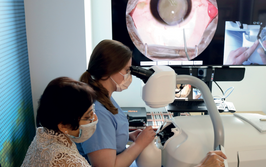A Digital Frontier
Could the Apple Vision Pro and spatial computing transform the ophthalmological landscape?
Tommy Korn | | 5 min read | Opinion

Credit: Headshot supplied by Tommy Korn
“Wow!” That was my reaction when I first received an early hands-on demo of Apple Vision Pro; at that moment, I realized the human race was about to enter a new era of computing.
Over the past two years, the medical field has witnessed the unveiling of groundbreaking technologies – from smartwatches that monitor heart function to generative AI, to wearable mixed-reality spatial computing ocular devices. And yet, as healthcare clinicians, we find ourselves at a contradictory crossroads, navigating through the fog of digital exhaustion from archaic, clunky 1990s’ electronic medical records to a sea of non-integrated, high-friction healthcare apps. Burnout is rampant, interoperability is a mere dream, and the essence of patient care is buried under layers of inefficiency – all of which contribute to poor patient access to care.
In the digital cacophony surrounding the world outside of healthcare, the advent of spatial computing – heralded by devices like the Apple Vision Pro – represents a beacon of transformative potential for our industry. This technology is not just another screen or gadget; it’s a paradigm shift in how we interact with information, bringing data to life in the three-dimensional space that surrounds us. A mixed-reality headset that can be viewed as a direct extension of the brain, the Apple Vision Pro promises an intimacy of interaction hitherto unimagined; these devices and their capabilities represent a type of cognitive augmentation only envisaged up until now in science fiction.
As eye care professionals, our role transcends the clinical; we are the custodians of vision, the gatekeepers of perhaps the most profound senses through which humans perceive and interact with the world. The introduction of this technology that sits so close to the eye, bridging the digital and the sensory, places us at the vanguard of a new era. We are uniquely positioned to guide this evolution, ensuring that, as society navigates this uncharted territory, we do so with a compass that points towards enhancing human health and its mental wellbeing.
Innovate with purpose – my digital health doctrine
Amid the buzz surrounding new technologies, the essential principles of digital health innovation should not be forgotten. At its core, we must ask three major questions when addressing any new digital technology:
- Is it safe – does it respect privacy and offer value for the user?
- Does it integrate seamlessly with existing systems?
- Crucially, can it scale effectively across varied healthcare environments to benefit all, while having an economic model that allows the innovation to survive?
Beyond these considerations, there’s an even more fundamental inquiry that underpins the very essence of any innovation, especially in healthcare: What is the job to be done?
As ophthalmologists, we need to question whether it’s necessary to “hire” this new spatial computing device. Will it significantly benefit our patients and our work lives? Does it fill a gap that existing technologies cannot? It’s about making a discernment between sustaining technologies – which either replace or enhance current methods – and disruptive technological innovations that might carve out entirely new markets and create new, unforeseen healthcare services.
I believe that disruptive innovations are the shot in the arm that healthcare desperately needs, and when the correct job for a new technology is identified, that’s when disruptive innovation comes into play. For example, take the advent of smartphones. No one could have predicted the rise of social media, telehealth, or the use of integrated cameras for medical imaging and diagnostics. These weren’t just enhancements to existing gadgets; they were harbingers of new industries, new ways of connecting, and previously unimaginable applications in healthcare. Such groundbreaking mobile technologies laid the groundwork for creation of new businesses and industries.
The realm of spatial computing and VR/AR (virtual reality/augmented reality) devices in healthcare is ripe with potential for transformative applications in new markets. Imagine technology-assisted surgeries that allow for unprecedented precision, aligning lens implants perfectly or executing meticulous incisions tailored to the individual’s unique eye anatomy. This isn’t just innovation; it’s a reimagining of possibilities – a leap toward a future where the precision and efficacy of medical interventions promotes an unforeseen culture of patient safety.
As possibilities are reimagined, innovators must recognize that new technologies are akin to living organisms – they require continuous nurturing, development, and adaptation. You simply can’t create an app or hardware technology, walk away and expect it to prosper. To avoid adding to the existing technological clutter in healthcare, innovators must make a sustained effort to integrate, maintain, and evolve these innovations.
Privacy, eye health, and balance
Prolonged use of wearable ocular devices could pose tangible risks to corneal health, including dry eye syndrome from reduced blink rates. As such, the close proximity of these wearables underscores a profound responsibility for ophthalmologists: to safeguard not only the physical health of the eyes, but also the private, sensitive data these devices can capture.
Eye tracking will be used by wearable eye computers as the primary interface modality, and this ability to record eye tracking is like monitoring someone’s thoughts. Without a doubt, privacy must be the most sacred principle to uphold in this circumstance. Iris authentication is also unique to humans, and this data must also be safeguarded at all costs. As eye care clinicians, we can provide the expertise for guiding technology companies in how to ethically use this sensitive information without compromising the safety and privacy of the users.
Beyond the physical, there's also a psychological risk to consider – mental burnout and societal disconnection. In our pivotal role, we must guide the integration of mixed-reality/virtual technologies with a balanced perspective, ensuring that, as we look forward to new horizons of human-computer interaction, we also reiterate how important it is to take a break from these new devices and reconnect with the real, physical world. Maintaining a healthy balance between the natural world and the digital realm is key to maintaining a healthy life in the 21st century and beyond.
As we navigate this exciting yet daunting landscape, we must do so with foresight, compassion, and an unwavering commitment to the principles that have always guided our profession. The future of ophthalmology in the age of digital innovation is not just about adapting to new technologies; it’s about shaping them to serve our highest purpose – the improvement of human health and vision, while simultaneously respecting the uniqueness and privacy of each patient.
Tommy Korn MD, Ophthalmologist and Chief Physician Evangelist - Digital Health Innovations at Sharp HealthCare, Spatial Computing Center of Excellence, San Diego, California.













